Authors who write Passover children’s books have approached the subject in many different ways. Some books are intended to be read solo while others are meant to be read aloud. Many books are filled with facts and fall into the category of non-fiction while another group are story based. Here is a selection of 6 Passover children’s books that are worthy of consideration.
1. General- Early Reader
Passover (Millbrook Press, 2006) By Cathy Goldberg Fishman and Illustrated by Jeni Reeves.
Few beginning chapter books are written for a Jewish audience. Passover by Cathy Goldberg Fishman is a rare find. It is part of the On My Own Holiday Series by Lerner Publishing Group. Cathy does a remarkable job creating appropriate language for intermediate level readers (Grades 2-3) while simultaneously consolidating the story of the Exodus from Egypt with the rituals associated with Passover. The book includes all of the age appropriate parts of the story and the customs that are usually practiced by Jews. Some kids may need assistance with the more difficult vocabulary. The illustrations by Jeni Reeves add to a struggling readers understanding of the text. A glossary of Passover words includes phonetic pronunciations that are useful for anyone unfamiliar with this vocabulary.
2. Fractured Tale
The Matzo Ball Boy (Dutton Children’s Books, 2005) By Lisa Shulman and Illustrated by Rosanne Litzinger.
The classic story of the Gingerbread Man has taken on a Jewish flavor in The Matzo Ball Boy picture book. In this version, the setting is Passover and the main character is made out of matzah meal instead of flour. Like the original story, a woman chases after the handmade boy. However, in this story the characters who join in the chase have Jewish characteristics and sprinkle Yiddish words here and there. The matzo ball boy is sly and is able to outwit a fox swimming across the river. However, a poor man and woman coax him into a pot of soup and cut the matzo ball boy’s life short. This rendition is a cute offshoot of the original story that will delight a Jewish audience. A glossary with a pronunciation guide is helpful for anyone unfamiliar with the vocabulary. Parents and teachers can use this ethnic adaptation to compare to other fractured tale picture books.
3. Midrash Tale
Nachshon, Who Was Afraid to Swim: A Passover Story. Kar-Ben, 2009) By Deborah Bodin Cohen and Illustrated by Jago.
Deborah Bodin Cohen uses parts of a Midrash story to create Nachshon, Who Was Afraid to Swim. The story is set in Egypt just prior to the Exodus. Nachson is a young Israelite slave who is afraid to swim. Nachson longs for the freedom that his ancestors once enjoyed. He looks up to Moses as someone who can make his dreams become reality. He listens intently when Moses says, “Real freedom means believing in yourself. Real Freedom means facing your fears and overcoming them.” When the Israelites head toward the Sea of Reeds, Nachshon is near the front of the group. As the Egyptians approached, Nachshon recalled Moses’ inspiring words and walked into the water. As Nachshon focused on Moses’ words, he overcame his fears. Before the water went past his shoulders, it receded. On the other side of the river, Nachshon was free in all respects.
This uplifting tale is a wonderful addition to a Passover and general book collection. The story can be read year round to enforce the meaningful message that it is important to face one’s fears and have confidence in one’s ability.
4. Folklore
Rachel’s Gift (Tundra Books, 2003) By Richard Ungar.
Jewish folklore is filled with stories about the mythical foolish people who lived in 19th century Chelm. Richard Ungar added to this collection when he created Rachel’s Gift. This story is an offshoot of I. L. Peretz (1852-1915) classic Yiddish story, The Magician. As the Jews of Chelm are preparing for Passover, one family is seeking to lure Elijah the Prophet to its home. As Rachel’s mother makes a pot of soup, the odor lures a variety of neighbors into the home. The mother is fixated on finding a way to have Elijah bestow good fortune on her family while Rachel is more concerned with meeting the needs of the strangers who visit. Unknowingly, Rachel interacts with Elijah and receives a small token of his appreciation. Her mother dismisses the gesture. Rachel has a broader viewpoint when she states, “…sometimes the right little something can make a world of a difference.” Richard’s vibrant illustrations will remind readers of Chagall’s work. They accentuate European Shtetl life in 19th century.
People who are unfamiliar with the rituals associated with Passover or the Jewish folktales associated with Chelm will not be able to grasp all of the layers of this story. The author did not provide any explanatory notes that would add a better understanding of the story.
Award:
- 2003 Notable Book for Young Readers by The Association of Jewish Libraries
5. Multicultural Passover Books
Passover Around the World (Kar-Ben, 2007) by Tami Lehman-Wilzig and Illustrations by Elizabeth Wolf.
Passover Around the World is geared toward an older children’s audience. (Upper Elementary- Middle School) It begins with a brief overview of Passover that is followed by a description of the traditional symbols that are found on a Seder table. Next the author highlights traditions and customs that are observed in the US, Gilbrator, Turkey, Ethiopia, India, Israel, Iran, and Morocco. These customs have been handed down from generation to generation. Colorful maps, illustrations, sidebars of additional facts, and recipes supplement each section. Oftentimes the information is shared via dialogue. This format may appeal to readers who normally do not seek out non-fiction. Tami includes a multitude of little known facts that will certainly fascinate inquisitive young readers as well as adults. Additional customs are discussed in a two-page section called Passover Potpourri. A handful of additional recipes are located near the end of the book. A glossary adds to the understanding of unfamiliar words.
6. Modern Israel
Jodie’s Passover Adventure. (Kar-Ben Publishing, 2012) By Anna Levine and Illustrated by Ksenia Topaz.
I hesitated to include this picture book in a list of Passover books. Even though the word Passover is part of the title, the holiday is only mentioned briefly. The story is set in modern Israel during Passover and takes place at the archaeological ruins at Hezekiah’s Tunnel. King Hezekiah was one of Kings of Judea. He reigned in the late 8th and early 7th century BCE.
The main character, Jodie, would like to follow in her father’s footsteps and become an archaeologist. She is eager to show her cousins the famous underground tunnel that was built to keep Jerusalem safe in the event of an attack. During her adventure, she brings a flashlight that she had received for finding the afikomen during her Passover Seder and matzah sandwiches. The illustrations highlight the dichotomy of Jerusalem- archaeological ruins amidst modern buildings and the eeriness of walking through a dark and wet tunnel. As Jodie and her cousin explored, they were able to solve the “riddle of the middle” and also retrieve an ancient coin. Even though the story does not focus on Passover, it provides valuable information about Israel and the importance of archeology. An author’s note or explanation would have enabled readers to understand more about ancient Israel and Passover.
Related Blogs:
Four New Picture Books for Passover
Two Passover Books by Lesléa Newman
New Activity Book for Passover- Frogs in the Bed
Picture Books for the High Holidays
Holocaust Picture Book Illustrates lost European Synagogues
Two Jewish Children’s Books for Thanksgiving
Multicultural Picture Book- Benjamin of Tudela
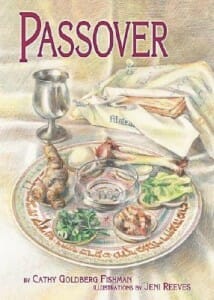
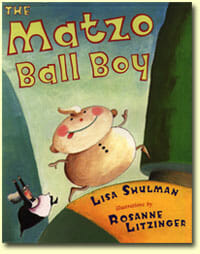
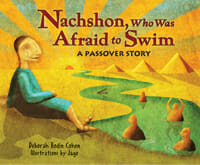
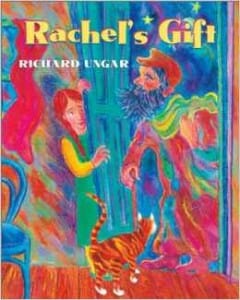
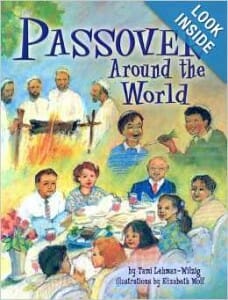
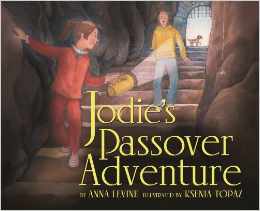
Leave a Reply
You must be logged in to post a comment.